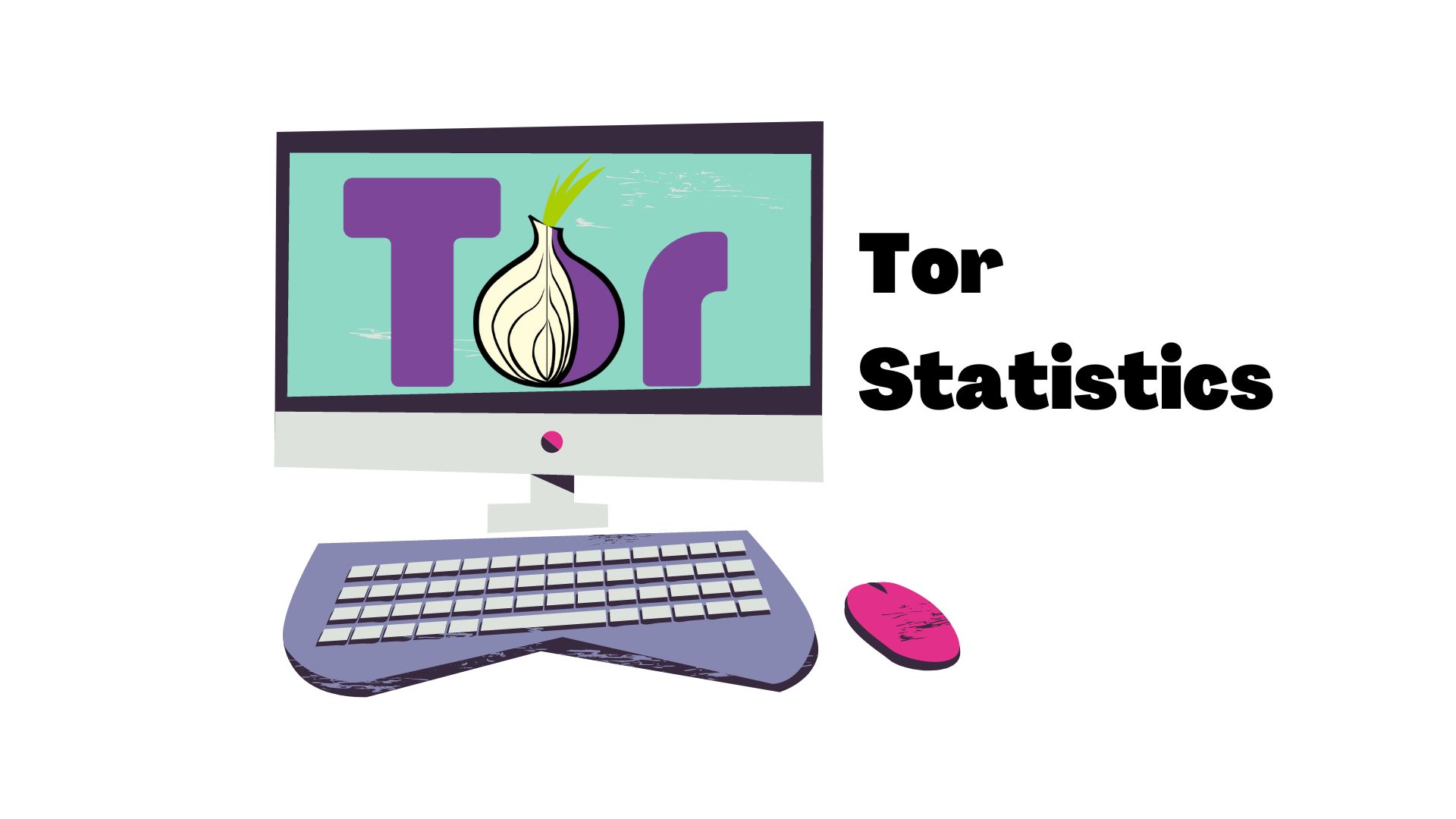Fashion Industry Statistics- Recent Facts

Page Contents
- Introduction
- Editor's Choice
- What is Fashion Industry?
- General Fashion Industry Statistics
- US Fashion Industry Statistics
- Fashion Industry Statistics by Sectors
- Fashion Industry Statistics by Region and Demographic
- Fashion Industry Impact on Environment Statistics
- Fashion Industry’s Impact on the Economy
- Fashion Industry Trends and Predictions
- Bottom line
Introduction
Fashion Industry Statistics: Fashion industry businesses generate billions in global annual revenue and contribute greatly to both employment opportunities as well as income production for different enterprises involved. Consumer trends change frequently within this market that are heavily impacted by factors like culture, technology, and social media.
Fashion has evolved over time to become more ethical and transparent, placing more importance on these principles. Yet many obstacles still must be addressed such as waste management, worker rights protections, and supply chain transparency.
- By 2023, it is expected that the global clothing market would reach $1.5 trillion.
- Over 60 million individuals work in this sector worldwide.
- 10% of global carbon emissions can be traced back to fashion industry activities.
- Since 2003, consumers have purchased 60% more clothing but retained each piece for half as long.
- By 2030, it is predicted that the market for used apparel could reach $80 billion.
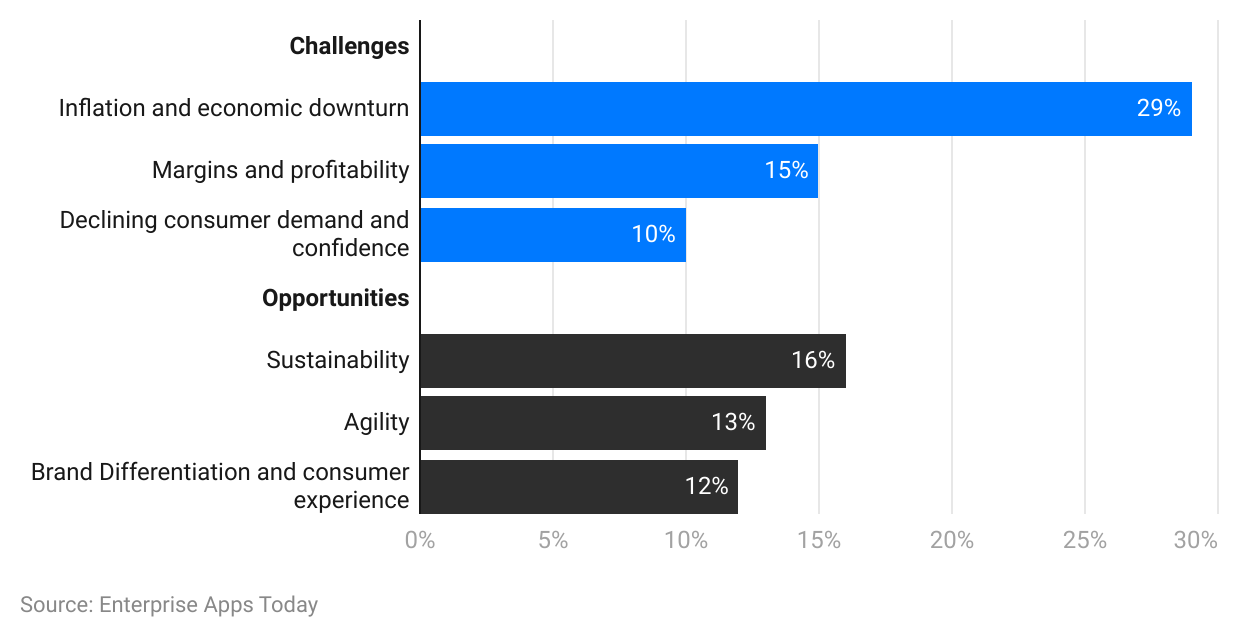
Based on a 2022 survey of fashion experts worldwide; sustainability is considered the top prospect for fashion retail brands. Approximately 16% of those surveyed identified sustainability as the main opportunity in the fashion industry for 2023. Meanwhile, economic decline and inflation were the most significant challenges predicted for the industry in the same year.
Editor's Choice
- Global clothing market revenue is expected to reach $1.7 trillion by 2022.
- In the US, 20-25% of stores were projected to close by 2020.
- Experts estimate a 30% surge in online fashion sales within the US in 2021.
- 58% of US consumers stated that purchasing ethical products would increase their spending.
- 34% of fashion companies across North America and Europe were experiencing financial issues prior to the pandemic outbreak.
- Plus-size models were only cast for 1.4% of roles cast overall.
- Over 80% of men who purchase luxury fashion reported being willing to pay extra for eco-friendly clothing.
- By 2025, 65% of sourcing executives polled anticipated having full traceability from fiber to shop.
- Estimates show that fashion contributes 8% of global greenhouse gas emissions.
- 16% of the elite audience expressed an interest in animal welfare with regard to sustainable fashion.
What is Fashion Industry?
Fashion refers to the design, manufacturing, promotion, and retail of apparel, footwear, and accessories that are manufactured or produced on demand and sold directly to consumers. As a multibillion-dollar worldwide industry, it significantly contributes to the world economy by creating jobs and earning income for various companies ranging from local shops to multinational organizations. Clothing lines designed and produced are subject to fast-evolving consumer tastes and fast-changing fashion trends in this extremely dynamic business which can be greatly affected by culture, technology, and social media, with firms and designers constantly keeping abreast with changing fashion trends.
As waste reduction, supply chain transparency, and fair labor standards become ever more central to fashion business practices; so do sustainability and ethical practices become ever more prominent within this sector. Many fashion firms now employ sustainable production techniques that utilize recycled materials while using less water and energy consumption while decreasing the environmental effects of their operations.
The fashion industry remains plagued by various problems, including waste management, worker rights, and supply chain transparency. Labor rights issues arise as a result of widespread outsourcing to developing nations where labor costs less. Furthermore, apparel production contributes significantly to greenhouse gas emissions, water consumption, and textile waste generation.
Fashion industry players range from quick fashion outlets to high-end luxury labels, offering various pricing points and designs. While luxury labels like Gucci, Prada, and Chanel provide high-end apparel associated with distinction and exclusivity; fast fashion stores such as H&M, Zara, and Forever 21 offer fashionable apparel at more budget-friendly prices – perfect for customers wanting the newest trends without breaking their budgets!
E-commerce has transformed the fashion industry, with customers increasingly turning to it for purchases. Influencers and celebrities are using social media sites such as Instagram and TikTok to market items to their followers, which helps fashion firms expand their followings. Fashion firms must remain responsive and adaptive as consumer preferences change – that makes the fashion industry an agile enterprise!
General Fashion Industry Statistics
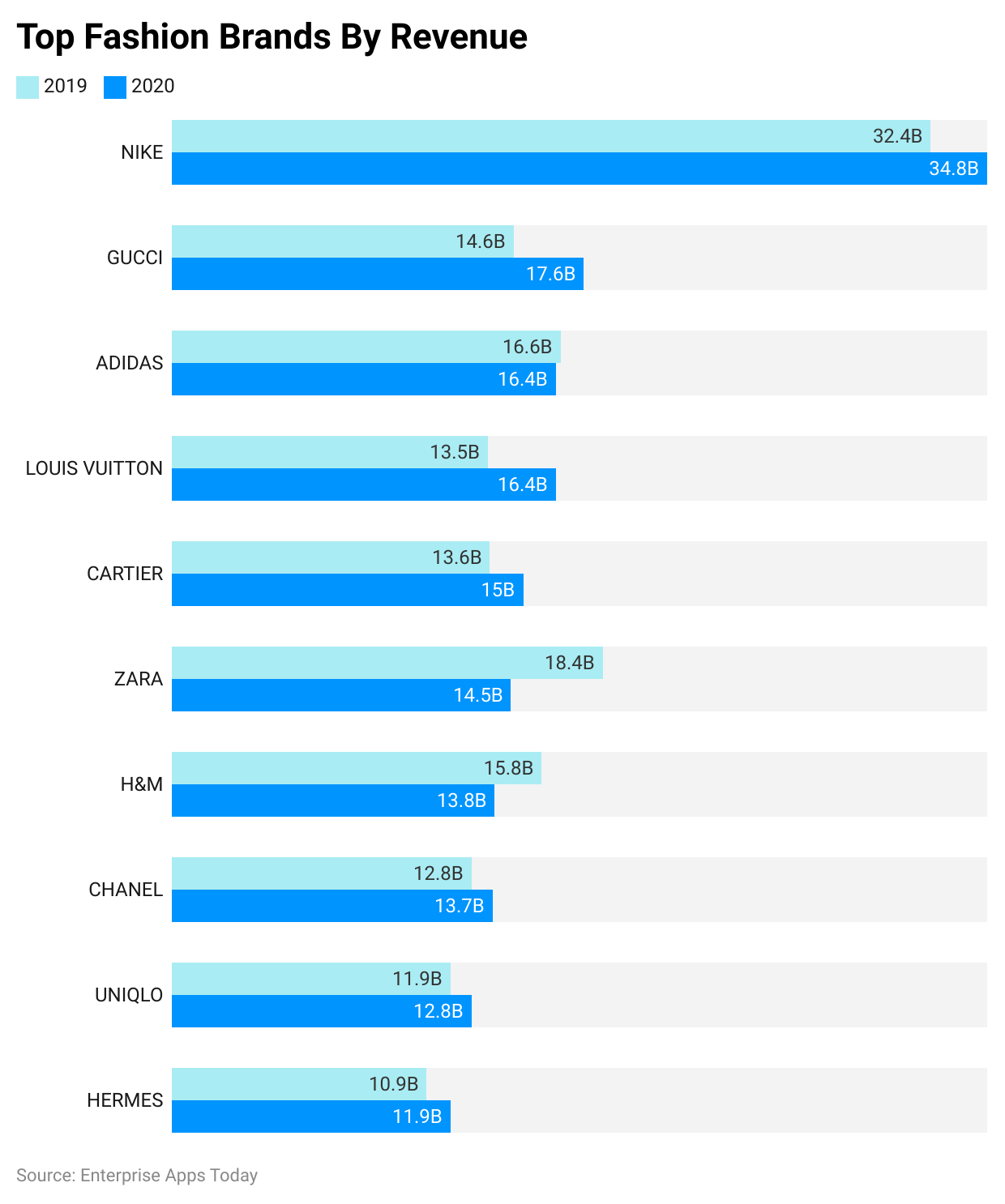
(Reference: thefashionstarter.com)
- With an estimated value of $2.5 trillion by 2020, fashion is a multi-trillion-dollar sector.
- Fashion industry employment worldwide stands at approximately 75 million jobs, making it a considerable source of employment.
- New York, London, Milan, and Paris host the four premier fashion weeks each year among over 40 others worldwide.
- Consumers annually spend billions of dollars on garments, with US apparel sales projected to hit $368 billion by 2020.
- Fast fashion, the business strategy that involves rapidly disseminating inexpensive goods at fast rates, has recently seen considerable popularity but has also been met with criticism due to its potential negative ramifications on society and the environment.
- Fashion firms specializing in luxury fashion typically dominate this sector of the industry and sell expensive merchandise at exorbitant costs. By 2020, luxury clothing sales were estimated to reach $300 billion worldwide.
- Fashion has fully embraced e-commerce and an increasing proportion of all sales are now happening online; 29% of global fashion sales were conducted via online channels in 2020 alone!
- Consumer concerns related to fashion industry emissions are creating pressure for companies in this industry to make changes that address its environmental footprint. Many are adopting circular economy ideas and investing in eco-friendly materials and production techniques in response to this environmental pressure.
- As demand for gender-neutral and size-inclusive clothing increases; fashion industry diversification is taking place. More diverse models are being featured in brand advertisements and collections that provide options that cater to more body types and genders.
- Technology has become an ever-more vital aspect of fashion industry operations as firms rely on technologies like 3D printing; virtual reality and artificial intelligence to increase product offerings and marketing techniques.
US Fashion Industry Statistics
Fashion in the United States plays an essential part in its economy and draws a wide range of participants, such as designers and producers, merchants, and customers.
- In 2020, the US clothing market held an estimated value of $225.5 billion – making it among the world's largest.
- Over 1.8 million individuals are employed in this sector, with California, New York, and Texas accounting for the vast majority of positions available.
- New York City serves as an important hub of the fashion industry with over 900 fashion businesses and 6,000 showrooms and offices, offering ample opportunity for businesses to thrive within this sector.
- Texas is the leading US cotton producer, producing significant volumes of wool, silk, and synthetic fibers as well.
- An average American typically purchases approximately 64 pieces of clothing annually, with women purchasing more apparel than males.
- China, Vietnam, and Bangladesh are the top three suppliers of imported clothing to the US market. Furthermore, America is currently one of the leading importers of textiles and apparel worldwide.
- COVID-19 has had an impactful, detrimental effect on the US fashion sector. Many stores and manufacturers reported sales decreases of 19.6% year-on-year with specialty stores taking the biggest hit.
- Ethical and sustainable standards within the US fashion business are increasingly receiving consideration. In 2020, The Sustainable Apparel Coalition introduced the Higg Index as a way of measuring social and environmental effects associated with clothing and footwear products. Many US fashion retailers and companies have also pledged their commitments to lower carbon footprints and improve supply chain transparency.
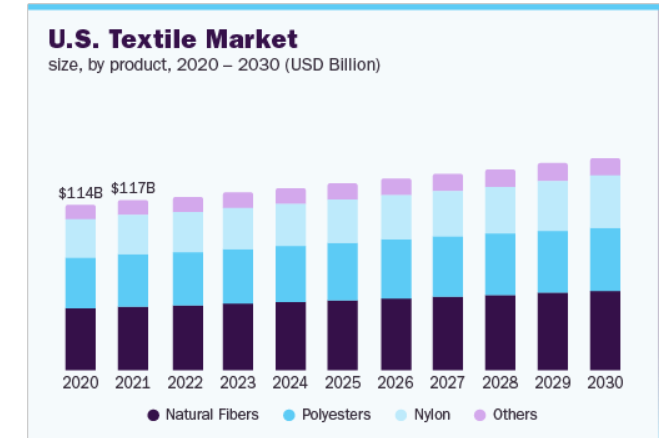
(Source: grandviewresearch.com)
From high-end luxury firms to quick fashion outlets, the US fashion sector comprises an eclectic group of participants. Notable fashion labels in this sector include Calvin Klein, Ralph Lauren, Tommy Hilfiger, and Michael Kors as just four examples; online sales now make up an increasing share of retail sales, making e-commerce an ever-more important channel for US fashion businesses.
The Fashion Institute of Technology (FIT), Parsons School of Design in New York City, and Otis College of Art and Design in Los Angeles are three premier fashion schools in the US. As an industry that involves retailers, manufacturers, designers, and more – fashion makes an economic contribution that benefits all Americans.
Fashion Industry Statistics by Sectors
Indian fashion business saw apparel sales account for 81% of total sales in 2017. Fashion in India has historically been heavily influenced by culture and geography; however; more Western and fusion trends are beginning to shape Indian customs over time.
The fashion business comprises several areas, each of which has its own specific trends and data.
Clothing
In 2020, it was estimated that the global clothing market was worth an estimated $1.5 trillion with the United States being its primary market. Clothing emissions make up roughly 10% of all emissions worldwide making this one of the worst polluters.
Footwear
By 2020, it was estimated that the global footwear market was estimated to be valued at $365.5 billion. The three most lucrative markets were believed to be the US, China, and the EU; recently though there has been a significant expansion of sports footwear markets spurred on by athleisure and sustainable fashion trends.
Fashion Accessories
In 2020, it was estimated that the fashion accessory market was worth an estimated $56.7 billion globally, with US and EU being two major markets for accessories sales. Accessories can be divided into three main categories – handbags, jewelry, and watches.
Luxury
In 2020, it was estimated that the global luxury goods market totaled $320 billion, with major markets such as the US, China, and Europe accounting for most sales. The pandemic impacting customer spending habits on experiences and commodities rather than luxury items.
Quick Fashion
H&M, Zara, and Forever 21 have been at the forefront of fast fashion's expansion for some time now. By 2020, estimates put its worth at $35.8 billion across three main regions (US, Europe, and APAC), yet critics continue to raise their voices against its environmental and societal effects.
E-Commerce
The rise of e-commerce has profoundly altered the fashion sector, as an increasing percentage of retail sales take place online. The largest markets for fashion e-commerce include the US, China, and Europe with combined market values exceeding $759 billion by 2020.
Sustainability
With many retailers and brands vowing to reduce their environmental footprint and increase supply chain transparency, sustainability has taken on increased significance within the fashion industry. By 2020, sustainable clothing was estimated to be worth approximately $9.81 billion worldwide, with Europe and North America constituting two of its primary marketplaces.
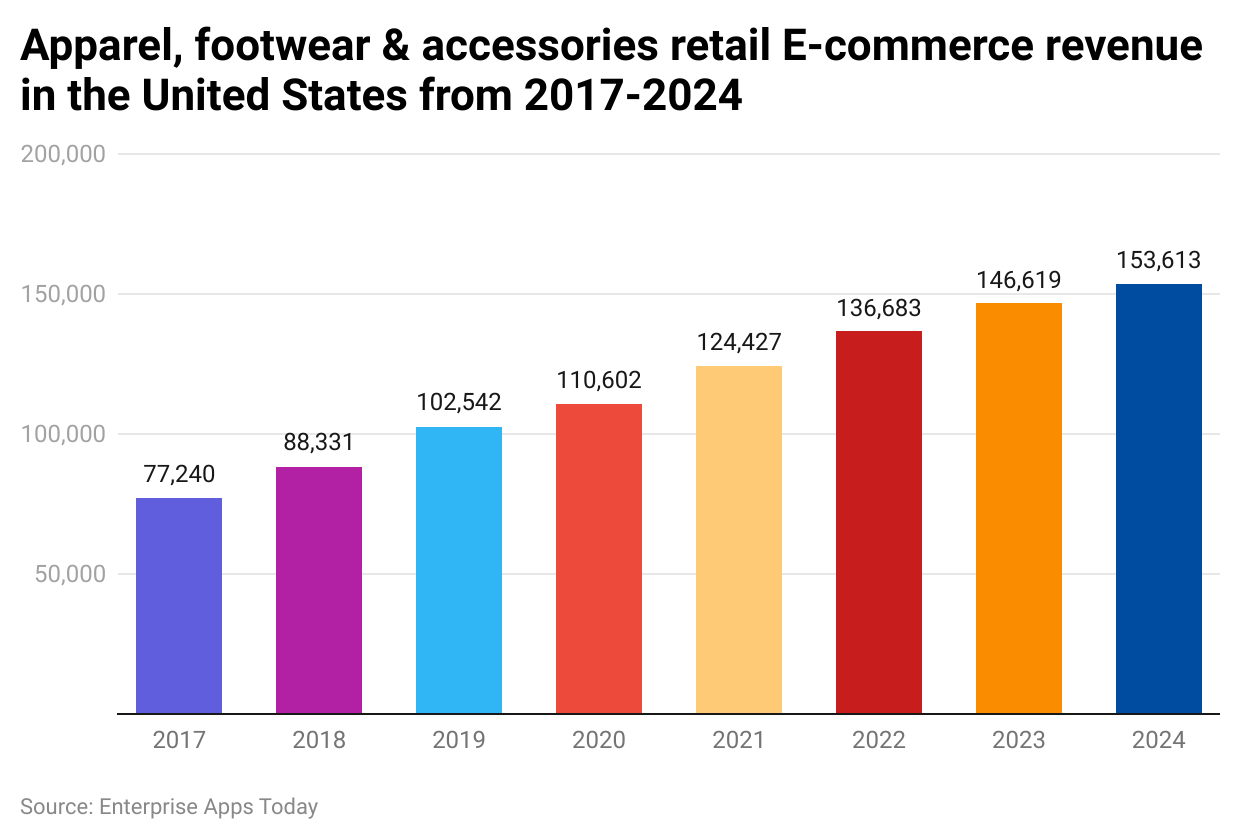
(Reference: fashiondealersociety.com)
Fashion Industry Statistics by Region and Demographic
2023 projections project only modest sales growth across Europe, the US, and China; two percent growth may occur for each of them while an optimistic estimate for China indicates seven percent. Europe saw lower-than-expected estimates while US estimates were less dramatic.
Fashion is an international market with interests and spending patterns that differ according to region.
- North American fashion sales account for an impressive portion of global garment sales, making the North American fashion market one of the largest worldwide. In 2020 alone, apparel sales totaled an estimated $368 billion in the US alone.
- Many of the largest fashion brands in the world are located in Europe, making Europe's fashion market an important one on the international stage. According to estimates from 2020, its clothing market was worth an estimated $307 billion with key marketplaces the UK, Germany, and France being key contributors.
- Due to rising earnings and increasing customer demand, the Asia-Pacific fashion industry is one of the fastest-growing sectors worldwide. Projected to reach $341 billion by 2020, China will be by far the biggest fashion market within this region; other notable fashion markets in this region include South Korea and Japan.
- Demand for apparel brands made of sustainable and socially responsible fabrics is on the rise across Latin American fashion industries, with Brazil serving as its hub. Estimates estimate its market size will surpass $51 billion by 2020.
- Premium fashion labels are becoming more fashionable. By 2020, their market size could surpass $15 billion; the United Arab Emirates is home to the region's biggest fashion market and an expanding Middle East and African fashion industry.
By Gender
The women's apparel market is massive and fashion companies profit tremendously from it. Women are expected to project an attractive physical image by wearing fashionable clothing that showcases their individuality and creativity.
- The women's fashion industry is forecast to experience a compound annual growth rate of 4.7% up until 2025.
- By 2021, it is anticipated that the women's apparel market will surpass $165.4 billion.
- American women aged 35 to 44 spend an estimated annual expenditure of $960 on apparel purchases.
- Only 20-30% of clothing stored in women's closets is actually worn by them.
- Men: Males account for only a smaller market than women in terms of fashion sales, they still represent an influential segment of it. With increased interest in grooming products and accessories for men's fashion becoming ever more prevalent, this sector became one of the fastest-growing markets worldwide in 2020 with total US market revenue exceeding $85.5 billion!
- Gender Non-Conforming and Non-Binary People: Fashion brands serving this market have become increasingly popular with younger customers who appreciate gender-neutral clothing and accessories.
- Diversity and Inclusion: The fashion industry has long been accused of lacking diversity and inclusion elements, particularly with regard to color and body type representation. But increasingly businesses recognize this need and are taking steps to address these concerns.
Ethical fashion can be hard to define due to its broad definition and diverse standards and interpretations of what constitutes ethical businesses; making identification challenging. According to this statistic, ethical fashion must fulfill several criteria such as being sustainable; fair trade, and free from abuse or exploitation throughout its supply chains – with 2021-2025 projected growth surpassing three billion dollars each year.
By Age
- In 2018, the market for children's apparel totaled an estimated value of $169 billion.
- By 2023, it is projected that the market for children's clothing will have been worth $239 billion.
- Gen Z, those born between 1997 and 2012, is fast emerging as an influential customer segment within fashion retail. Estimates put their buying power at approximately $143.5 billion; these individuals tend to favor businesses that promote environmentally responsible practices as well as businesses with social impact goals.
- Baby Boomers (those born between 1946 and 1964), although among the oldest customer demographics in the fashion business, remain an impressive customer market. More likely than not they prioritize comfort over fashion trends due to their appreciation of functionality.
- Seniors (people over 65) represent a growing segment of the fashion market. This demographic prioritizes utility and usability when selecting clothing items, placing an emphasis on comfort and convenience.
Fashion Industry Impact on Environment Statistics

(Reference: theroundup.org)
Fashion has an enormous environmental impact, leading to issues surrounding pollution, waste management, and depletion of natural resources.
Water Usage: Estimates suggest that producing one cotton t-shirt consumes up to 2,700 liters of water, making the fashion sector one of the largest consumers of freshwater resources worldwide. Dyeing and finishing textiles also rank amongst the most water-intensive processes used around the globe.
Emissions of Greenhouse Gases: Fashion is responsible for approximately 10% of global emissions of greenhouse gases; dyeing, finishing, and transportation emissions account for most. Furthermore, this industry plays a pivotal role in microplastic pollution due to washing synthetic fiber garments which shed and end up polluting streams and seas.
Garbage: The fashion business creates vast amounts of waste; some estimates put annual textile production at over 92 million tons, most of which is sent off to landfills or incinerators, with only a small portion recycled or reused again.
Chemical Use: The fashion industry often makes use of dangerous, toxic substances such as insecticides and dyes that have adverse consequences for both people's health and the environment, including soil contamination as well as air, water, and soil quality pollution.
Deforestation: Fashion businesses have long been linked with deforestation, particularly textiles made of wood pulp such as rayon and viscose textiles. Their production can lead to significant habitat destruction as well as uprooting indigenous communities living nearby.
Fashion industry players have recently turned their focus to environmental protection and sustainability. Many shops and companies have pledged to reduce their environmental impact and enhance supply chain transparency.
Fashion Industry’s Impact on the Economy
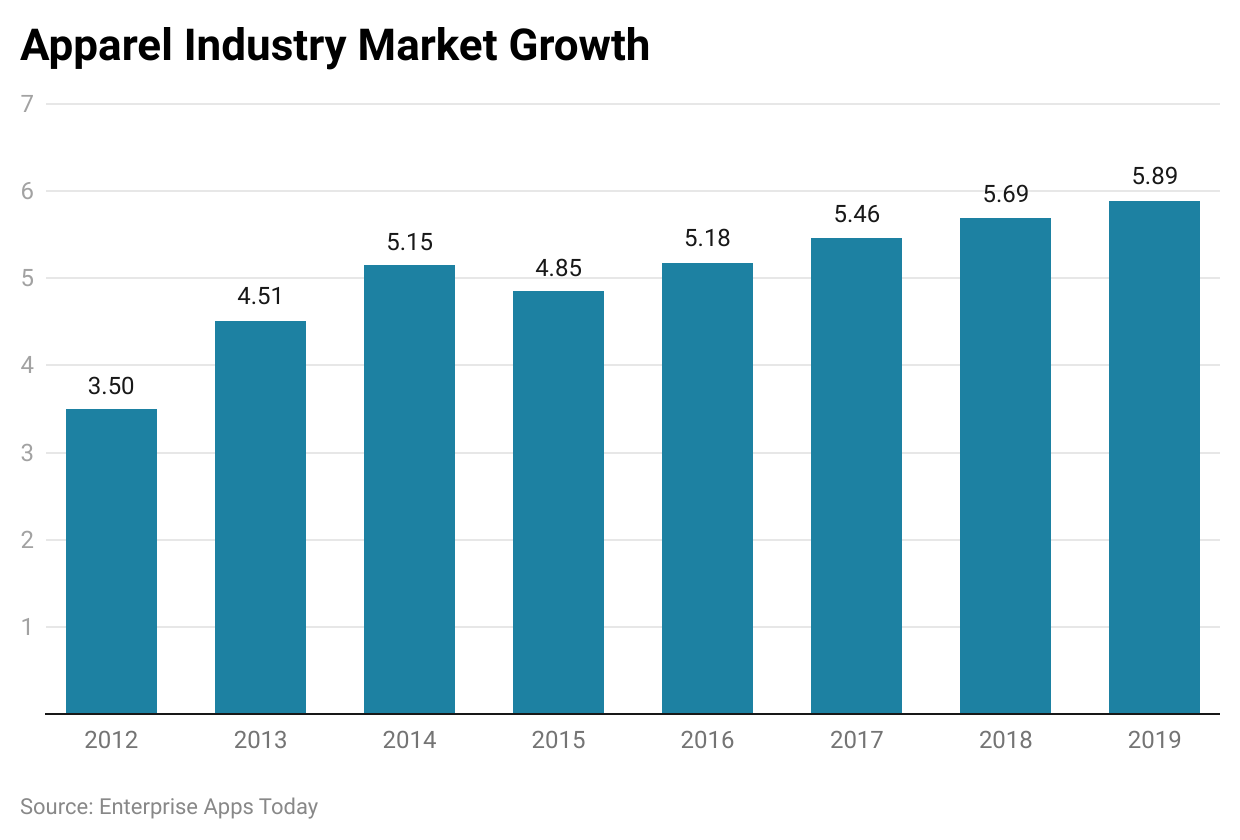
(Reference: fee.org)
Fashion contributes significantly to the global economy by generating billions in revenues and creating jobs across its supply chains.
- Contribution to the Economy: By 2020, US fashion retail sales alone are projected to surpass $384 billion; globally speaking, fashion is estimated to represent an estimated value of over $2.5 trillion.
- Employment: The fashion business offers positions across a range of fields, such as design, production, retail, and marketing. Over 1.8 million individuals reportedly hold employment within this sector in the US alone.
- Fashion experts are an integral component of economic development for certain nations; Bangladesh relies heavily on apparel exports as its second-largest exporter, producing over 80% of export revenue annually.
- Retail Sales: Clothing and footwear are consumer favorites, and fashion plays a prominent role in their popularity. Retail sales for apparel and shoes in the US alone surpassed $339 billion in 2020.
- Fashion weeks: Global fashion weeks can have an immense economic impact by increasing tourism and related businesses, according to estimates by New York Fashion Week alone, estimated at roughly $900 Million per year in economic activity.
- Technology and Innovation: The fashion industry is also an active proponent of technical advancement, investing in and driving technical advances such as supply chain management, e-commerce, and digital marketing.
Sustainability and social responsibility present significant challenges to fashion firms. Consumers and stakeholders have become more concerned with issues like environmental impact, labor exploitation, and supply chain transparency; thus many fashion companies have attempted to resolve such concerns by taking steps like providing transparency throughout their supply chains.
Fashion Industry Trends and Predictions
The fashion business is constantly shifting as new trends emerge and customer tastes evolve.
- As consumers become more environmentally aware, sustainable fashion has gained prominence as a trend. Companies are employing circular economy concepts while investing in environmentally-friendly materials and production techniques.
- This epidemic has hastened fashion designers' shift toward online purchasing, placing greater importance on digital channels like virtual and augmented reality experiences as well as investing in digital marketing and e-commerce strategies.
- By attracting more diverse models with gender-neutral and size-inclusive clothing lines, the fashion industry is expanding. More varied models are appearing in brand advertisements and collections to reflect an array of body shapes and genders.
- The pandemic has highlighted the significance of local supply chains and manufacturing, with customers preferring goods produced nearby. Brands have taken note, of showcasing regional tradition while investing in local supply networks and production.
- Due to an increasing trend of customers working from home, the demand for comfortable clothing suitable for both indoor and outdoor wear has grown significantly. Many brands have now created collections focusing on cozy textiles and functional designs in response to this need.
The fashion business is constantly shifting with changing customer tastes and new trends emerging, from comfort and adaptability, inclusion, digitization, sustainability, and localism being some of the key current trends and future projections of this industry. Brands that can quickly respond to trends by adapting product offerings or marketing techniques in response to these shifts will likely succeed.
Bottom line
The fashion business is an enormous multi-billion dollar worldwide industry with significant ramifications on jobs and economic activity. Responding to changing customer tastes and technological advancements, the fashion business includes goods ranging from quick fashion to luxury fashion trends. But like any industry, fashion also faces its fair share of challenges regarding its social responsibility and environmental impacts; consumers increasingly are becoming aware of these concerns which have led to an increasing desire for fashion products that are inclusive and sustainable.
Fashion companies that can adapt to current trends and challenges will likely experience long-term success. Fashion firms that can successfully do so can build loyal customer bases while spurring industry development by investing in eco-friendly materials and production techniques, supporting inclusion and diversity initiatives, and adopting cutting-edge technology. They may also increase trust by being transparent about their practices and supply chains – leading the way to an ethical fashion sector.
FAQ.
Nike currently holds a 2.8% market share in apparel sales worldwide and generated $44.5 billion, an increase of 19% year over year. Projected worldwide sales totalling EUR44.2 billion ($51.1 billion), both LVMH Mot Hennessy Louis Vuitton and Christian Dior Group both hold substantial market shares within the fashion industry.
In 2022; the global fashion market was estimated at being worth an astounding $1.7 Trillion with the US clothing market at $343.70 Billion and projected to expand further to $ 494.89 billion by 2023.
In 2021; the global fashion market was valued at an estimated total of $1.55 Trillion with the online fashion market estimated to exceed a value of $700 Billion before topping $1.95 Trillion by 2026.
Despite an epidemic-induced decline; the fashion business remained stable; with athleisure apparel showing tremendous growth led by Nike and Lululemon. Although forecasts indicated a slight dip in revenue between 2019 (531.25 billion vs 485.62 billion) and 2023 (672.71 billion).

Barry is a lover of everything technology. Figuring out how the software works and creating content to shed more light on the value it offers users is his favorite pastime. When not evaluating apps or programs, he's busy trying out new healthy recipes, doing yoga, meditating, or taking nature walks with his little one.

